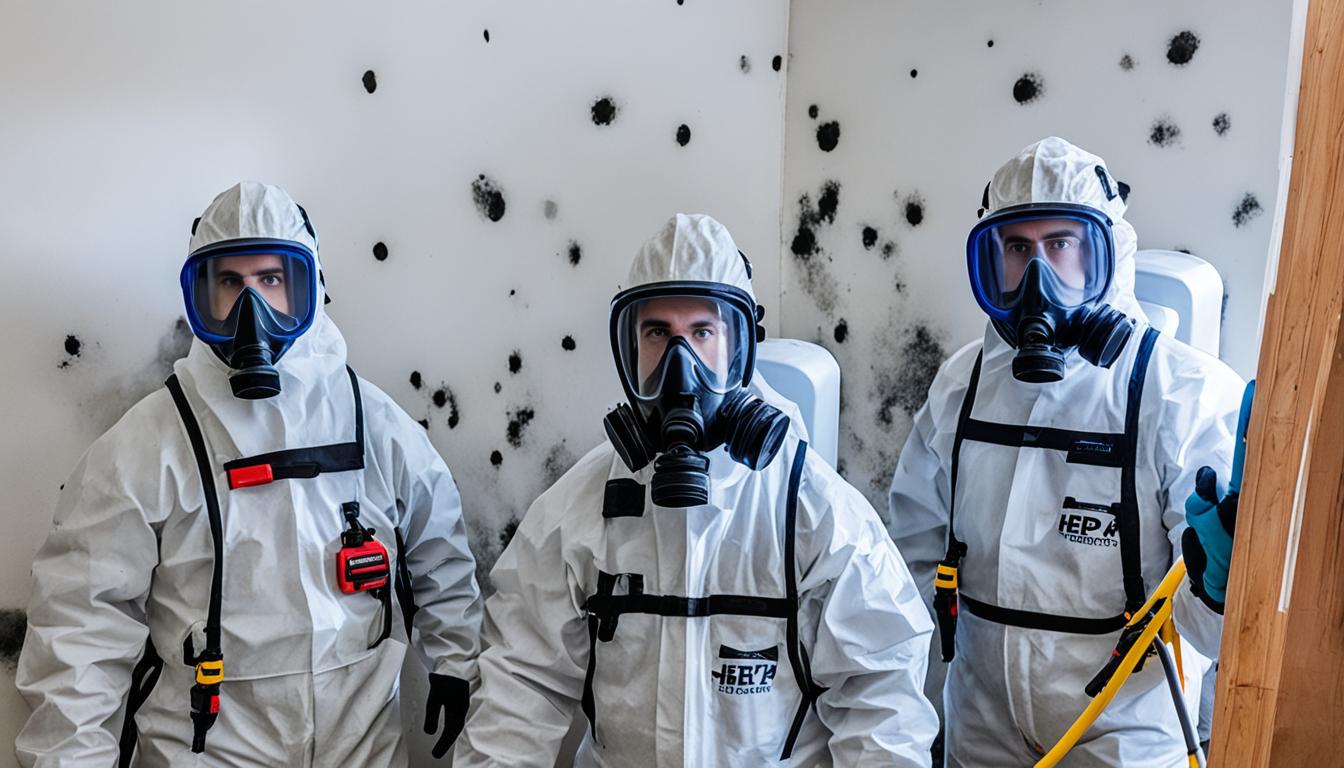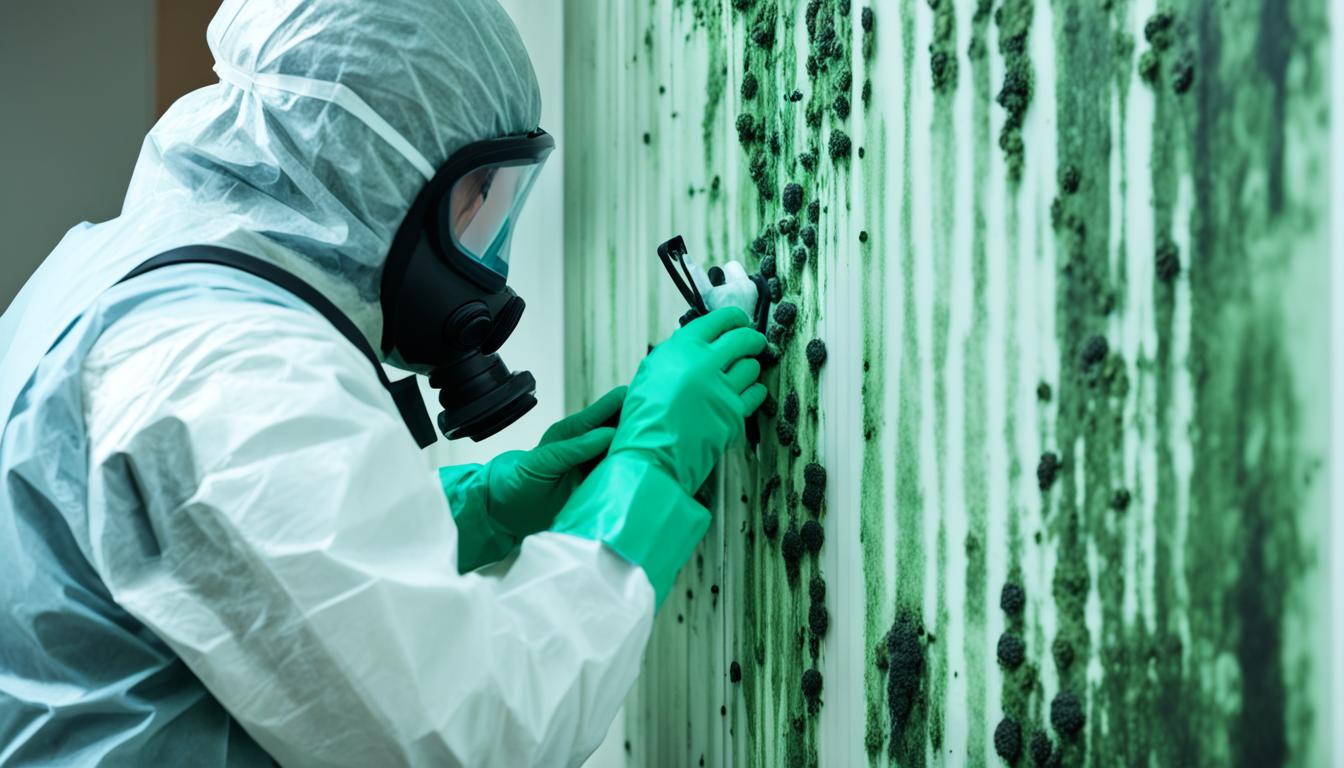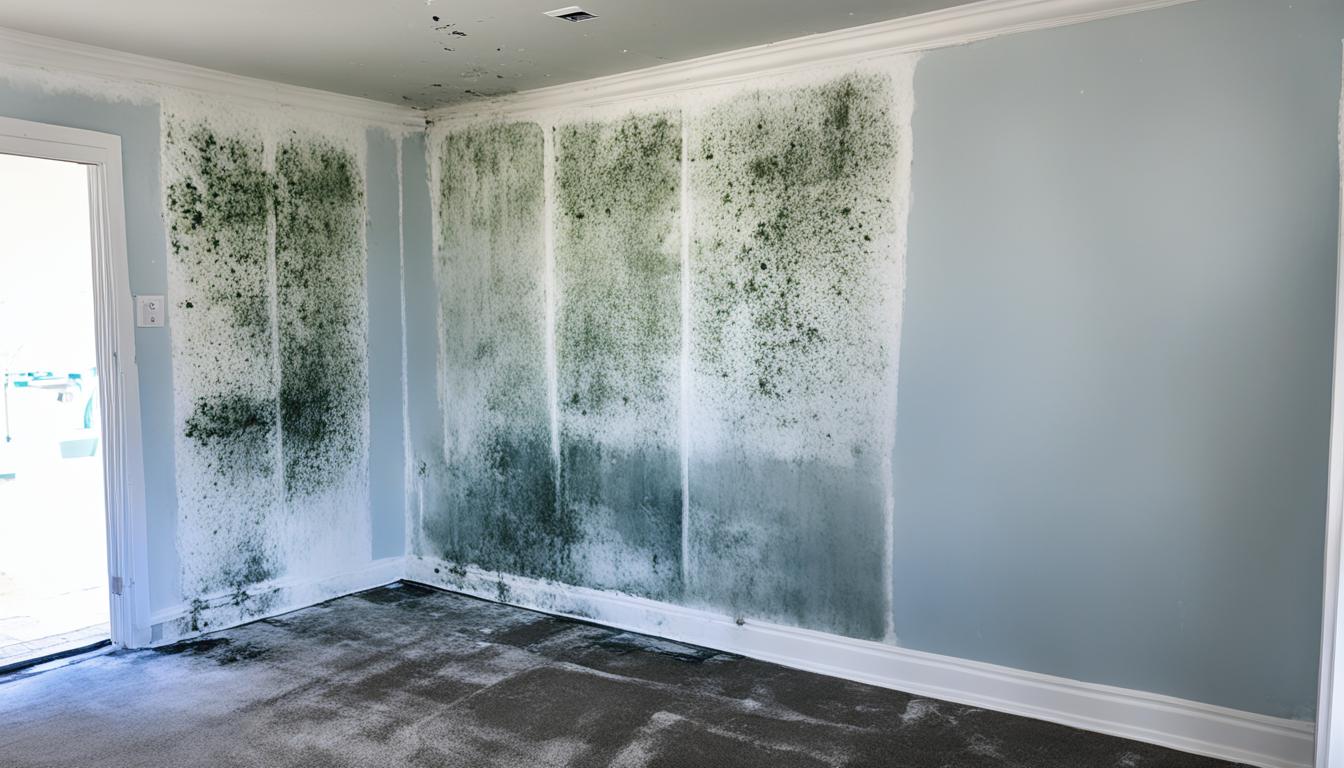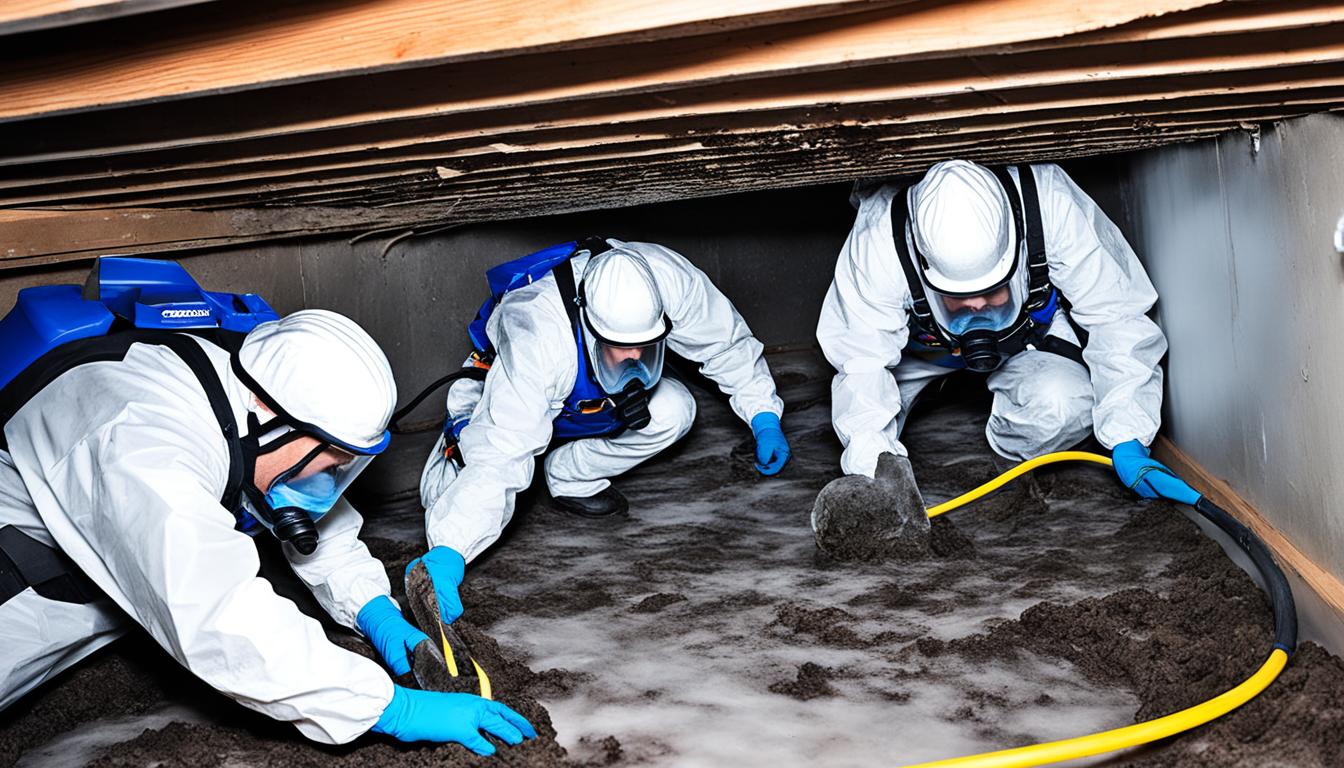
Black Mold Remediation: Effective Solutions Now
Welcome to our comprehensive guide on black mold remediation. In this article, we will explore the importance of eliminating black mold from your home and provide you with effective strategies to achieve a mold-free environment. By taking proactive measures, you can protect the health and integrity of your property.
Black mold, also known as Stachybotrys chartarum, is a toxic fungus that thrives in damp and humid environments. It poses significant risks to both your health and the structural integrity of your home. Understanding the characteristics of black mold and its dangers is crucial for taking appropriate action against its growth.
To ensure the effectiveness of black mold remediation, it is essential to invest in professional assessments. These assessments help identify mold growth and determine the extent of the problem. Additionally, implementing preventive measures can stop black mold from proliferating in the first place. Take control of your living environment by staying vigilant.
When it comes to removing black mold, utilizing effective techniques is key. Proper containment and removal procedures, along with specialized cleaning agents, can facilitate thorough mold removal. By following these expert tips, you can achieve successful black mold remediation and prevent future growth.
Key Takeaways:
- Black mold remediation is vital for a healthy and safe living environment.
- Understanding the dangers of black mold helps prioritize remediation efforts.
- Investing in professional assessments aids in identifying and addressing mold issues.
- Implementing preventive measures is crucial to preventing black mold growth.
- Utilizing effective removal techniques ensures thorough mold remediation.
Now that you have a comprehensive understanding of black mold remediation, you can take proactive steps to combat this hazardous fungus. By implementing the strategies outlined in this guide, you can create a mold-free living space for you and your family.
Understanding Black Mold and Its Dangers
Black mold, also known as Stachybotrys chartarum, is a type of fungi that thrives in areas with excessive moisture. It can often be found in damp and poorly ventilated spaces such as basements, bathrooms, and areas affected by water damage.
Understanding black mold is crucial because it poses various dangers to both your health and home. When black mold spores are inhaled or come into contact with your skin, they can cause a range of adverse health effects. It is essential to take prompt action to prevent and mitigate black mold growth to protect yourself and your loved ones.
Characteristics of Black Mold
Black mold has distinct characteristics that set it apart from other types of mold:
- Appearance: As the name suggests, black mold has a dark, blackish-green color. It often appears slimy and may have a slightly fuzzy or powdery texture.
- Growth: Black mold is typically found in areas with high humidity and dampness. It thrives on organic materials such as wood, carpeting, drywall, and paper. Moisture, combined with a lack of proper ventilation, creates an ideal environment for black mold to grow.
- Odor: One of the telltale signs of black mold is its musty and earthy smell. This distinct odor is often described as similar to damp soil or rotting wood.
Dangers of Black Mold Exposure
Exposure to black mold can lead to a range of health complications, particularly for individuals with weakened immune systems, respiratory conditions, or allergies. The dangers of black mold exposure include:
- Respiratory Issues: Inhaling black mold spores can trigger respiratory problems such as coughing, wheezing, and difficulty breathing. People with asthma or existing respiratory conditions may experience exacerbated symptoms.
- Allergic Reactions: Black mold spores can cause allergic reactions, including sneezing, itching, watery eyes, and skin irritation.
- Weakens Immune System: Prolonged exposure to black mold can compromise the immune system, making individuals more susceptible to infections and illnesses.
- Toxic Effects: In some cases, black mold can produce mycotoxins, which are toxic substances that have the potential to cause severe health issues. These toxins can affect the nervous system, leading to headaches, dizziness, confusion, and even neurological damage.
To safeguard your health and prevent further damage to your home, it is essential to address black mold issues promptly. If you suspect black mold growth in your property, it is advisable to consult professional mold remediation experts who can assess the situation and recommend the appropriate course of action.
Professional Black Mold Assessment and Prevention
When it comes to black mold, proactive measures are key to ensuring the health and safety of your home and loved ones. That’s why a professional black mold assessment is essential in identifying mold growth and understanding the extent of the problem.
During a professional assessment, trained experts will thoroughly inspect your property, looking for visible signs of mold and assessing the moisture levels in different areas. Through their expertise, they can pinpoint areas of concern that may be hidden from plain sight, such as behind walls or under flooring.
Once the assessment is complete, the experts will provide you with a comprehensive report detailing their findings. This report will include information on the type and severity of the mold growth, as well as recommendations for remediation.
But why wait for mold to become a problem? Prevention is always better than cure. By implementing effective preventive measures, you can stop black mold from proliferating and maintain a mold-free environment.
Preventive Tips to Keep Black Mold at Bay:
- Control indoor humidity levels: Use dehumidifiers in areas prone to moisture build-up, such as basements and bathrooms.
- Fix leaks promptly: Address any plumbing or roof leaks immediately to prevent water from seeping into the walls or ceiling.
- Ensure proper ventilation: Use exhaust fans in the kitchen and bathroom to remove excess humidity and moisture.
- Keep surfaces dry: Wipe down surfaces regularly, especially in areas prone to condensation.
- Improve airflow: Arrange furniture and belongings to allow for proper air circulation, reducing the chances of moisture buildup.
Remember, addressing potential mold issues before they become major problems is crucial. Investing in a professional black mold assessment and implementing preventive measures can save you from the costly and time-consuming process of mold remediation.
Now that you understand the importance of professional assessments and preventive measures, let’s explore effective black mold remediation techniques in the next section.
Effective Black Mold Remediation Techniques
When it comes to black mold remediation, employing effective techniques is crucial for a thorough and successful removal process. In this section, we will provide you with a comprehensive guide on how to effectively eliminate black mold from your home while ensuring its prevention in the future.
1. Proper Containment and Removal Procedures
One of the key steps in black mold remediation is to contain and remove the mold safely. This involves creating a containment area to prevent the mold spores from spreading to unaffected areas of your home. Use plastic sheets and tape to seal off the affected area, and make sure to wear protective clothing, gloves, and a mask.
Once the containment is in place, it’s important to safely remove the mold. While small patches of mold can often be cleaned with a mixture of detergent and water, larger infestations may require professional assistance. Experienced mold remediation specialists have the necessary tools and expertise to handle larger-scale removal safely.
2. Specialized Cleaning Agents
Using specialized cleaning agents is essential for effective black mold remediation. These agents are designed to break down mold spores and kill the mold at its source. Look for products that are specifically formulated for black mold removal and follow the instructions carefully.
Common cleaning agents used in black mold remediation include hydrogen peroxide, vinegar, and borax. These natural solutions are effective in killing mold and preventing its regrowth. Remember to always test a small, inconspicuous area before using these cleaning agents on a larger scale.
3. Thorough Inspection and Drying
After removing the visible mold, it’s crucial to conduct a thorough inspection of the affected area to ensure no hidden mold remains. Use moisture meters and thermal imaging cameras to identify areas with high moisture levels that might be conducive to mold growth.
Once the mold is removed and the affected area is dry, it’s important to address the underlying cause of the moisture problem. Repair any leaks or water damage promptly to prevent future mold growth.
4. Professional Consultation and Assistance
While DIY black mold remediation can be effective for small, localized outbreaks, larger infestations or recurring mold problems may require professional consultation and assistance. Professional mold remediation specialists have the necessary expertise, equipment, and techniques to tackle even the most challenging cases of black mold.
Consulting with a professional not only ensures thorough remediation but also helps identify and address any underlying issues that may contribute to mold growth. They can provide expert advice on moisture control, ventilation improvements, and other preventive measures to keep your home free from mold.
With these effective black mold remediation techniques, you can confidently tackle mold issues in your home. Always prioritize safety, follow proper procedures, and seek professional help when needed. By taking swift and effective action, you can protect your family’s health and maintain a mold-free living environment.
Conclusion
In conclusion, it is essential to prioritize black mold remediation in order to maintain a healthy and safe living environment. By understanding the dangers associated with black mold, investing in professional assessments, implementing preventive measures, and utilizing effective remediation techniques, you can protect both your home and the well-being of your household members.
Black mold poses serious health risks, including respiratory issues, allergies, and even potentially life-threatening conditions. Therefore, it is crucial to take proactive steps today to combat black mold and create a mold-free living space.
Remember, prevention is key. Regular professional assessments can help identify and address black mold growth in its early stages, while implementing preventive measures, such as moisture control and proper ventilation, can help reduce the likelihood of future mold outbreaks. If faced with black mold, engaging in effective remediation techniques, including proper containment and removal procedures, along with the use of specialized cleaning agents, can ensure thorough removal and prevent regrowth.
By prioritizing black mold remediation, you are not only protecting the value and integrity of your property but also safeguarding the health and well-being of your loved ones. Don’t wait until the problem worsens – take action now for a mold-free and healthier living environment.




